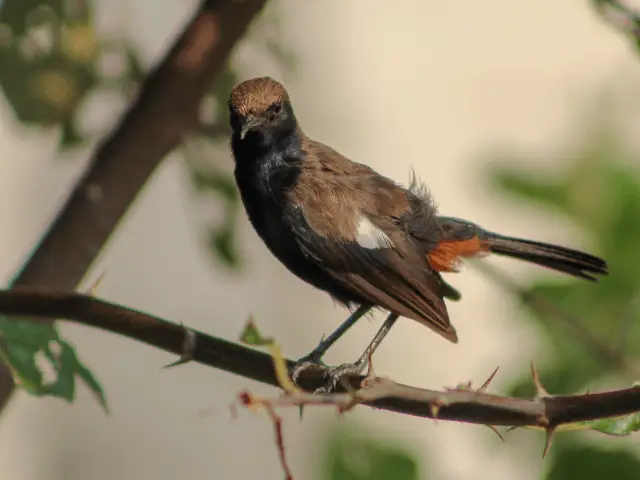California boasts a staggering array of natural habitats, from the endless coastlines to the valleys and mountains. The national parks, recreation areas, forests, and wildlife management areas are home to many common birds in California.
There are year-round birding opportunities across the state, and knowing more about these birds will foster a deeper appreciation of our ecosystem.
Thus...
If you want California bird identification to be more accessible, you will need all the help you can get.
After reading this article, it should no longer be necessary to wonder what bird species you will encounter in the state.
California Backyard Birds
Engaging people in a more profound understanding of California's biological diversity doesn't only lead to a fun birdwatching experience. It could lead to more interest in conserving and restoring natural ecosystems.
As a breeding ground for resident breeders, California supports the natural habitat of seasonal visitors and migrants from and to South America. Let's try and discover more about these common California birds and how we can best recognize them.
1. House Finch 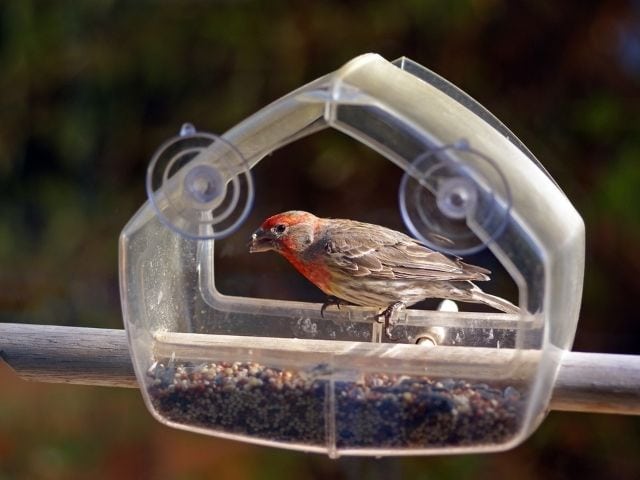
When trying to spot a house finch, you only need to look for the bold streaks on its chest; its bib, and head with a brick-red shade. Comparatively, females use their muted tones to help them stay inconspicuous during incubation or to draw less attention when feeding.
You will also encounter its kind in city and suburban areas, forests, parks and farms, and around human settlements. It's a highly sociable bird, which is why you might see it in small flocks in your backyard, enjoying sunflower seed, peanut, and suet at feeders.
House finches were once western species that made their first appearance on Long Island, New York, in 1940. After 20 years, the birds flew from Long Island Sound to Connecticut and stayed there for a while.
Like the American goldfinch, house finches nest in the open. These birds seem to like having the vantage point of overseeing a potential danger; they love nesting on houses and display an affinity for tube feeders.
Despite the bacterial disease that resulted in this bird's declining population in eastern North America, it continues to thrive and has become widespread throughout the continent.
2. Mourning Dove 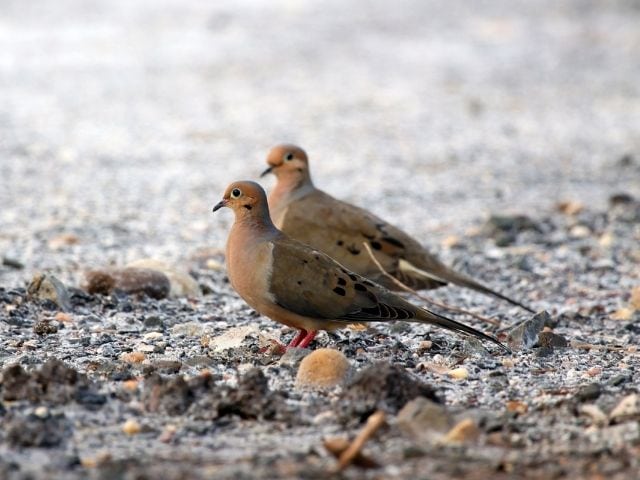
Mourning doves are a year-round species in California. You can recognize this bird with its sleek body, small round head, thin neck, and long tail. Aside from these notable features, this dove has a grayish-brown shade underneath, a darker upper section, and iridescent neck feathers.
A familiar presence in villages, farmsteads, and wild areas alike, these doves are one of the best-known birds of the Sierra foothills. The bird's streamlined appearance and tail feather, which are more noticeable when in flight, is unmistakable that even hunters can't miss.
It is not unusual that people mistake these birds for owls due to their similar-sounding "hoo, hoo" calls. A mourning dove's wings also make a loud, whistling sound when in flight, probably a way of alerting other birds of potential threats in the area.
This dove prefers ground-foraging for its favored meal, including grains and grass seed. It occasionally consumes acorns and pine seeds, and in rare instances, insects and snails.
Fun Fact: The Mourning Dove alongside other bird species is one of the most common attractions in the United States. In fact, this avian darling is on the list of the top 20 birds of Massachusetts!
3. California Towhee 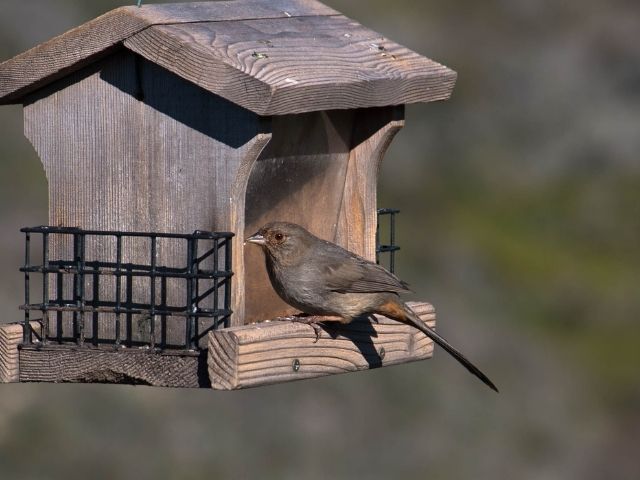
The plump California towhee with a drab plumage and dark streaks is a resident bird from southwestern Oregon to western California and Baja. This ground-feeding sparrow also has a short, conical bill with a long tail and cinnamon-colored under tail coverts.
California towhees are more common in Huntington Beach than the spotted towhee. You will have no trouble telling these two birds apart, as the spotted towhee is predominantly black with reddish-brown sides and a white belly.
Moreover, this stocky bird can be pretty sluggish, and you will often encounter it alone or in pairs. It enjoys chaparral or brushy habitats, such as thickets, dense shrubberies, or woodlands near streams and rivers, parks, and suburbia.
This plain-looking sparrow's diet consists of mixed seeds, grass shoots, insects, visiting ground feeders sometimes.
4. Black Phoebe 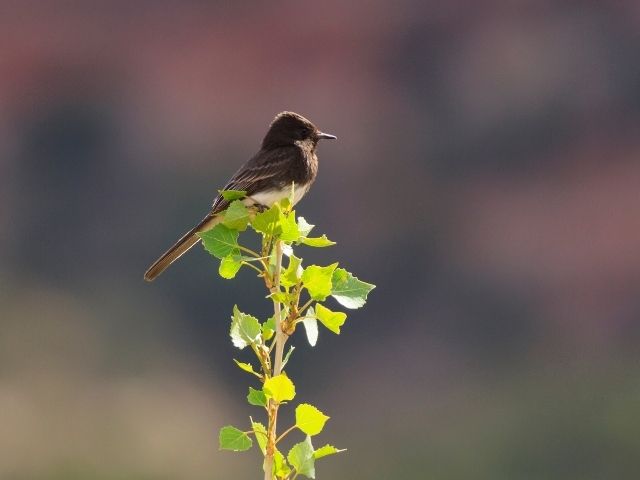
Black phoebes are all-year resident birds of foothill communities, abundant in the Central Valley and familiar in the Morro Bay Area. This flycatcher is among the backyard birds of Northern California with an extensive range from southeastern Oregon to South America.
You will sometimes notice the black phoebe dipping its tail up and down when perched, typically in an upright position. Flying insects are this bird's primary food source; it will catch these insects mid-air or dart to the ground, tugging them.
It relies on these insects in the cold months but would compete with other insect-eaters in summer. Despite being exclusively insectivorous, this flycatcher sporadically dives into ponds to catch a fish. It seizes small minnows or tiny fishes, which they sometimes feed to their nestlings.
If you're particularly interested in watching this bird, you can find it in areas close to water, nesting on natural cliffs, or under bridges. Nevertheless, it finds no trouble living close to humans, better than any native bird in the Sierra Nevada.
5. Lesser Goldfinch 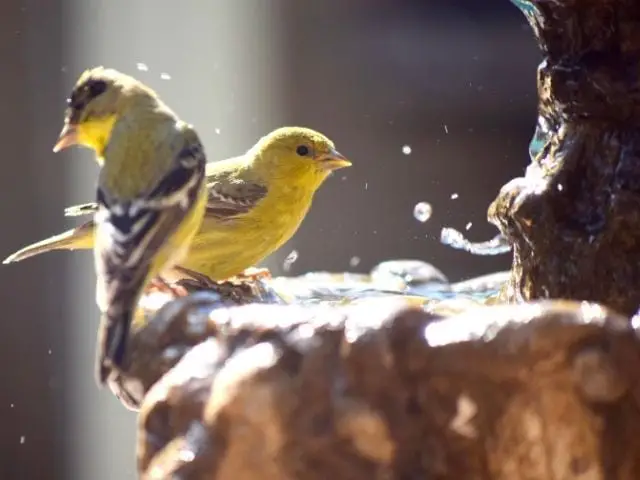
Being the smallest of the goldfinches is how the lesser goldfinch got its name. This songbird belonging to the Fringillidae family is a native bird to North America and the most widespread goldfinch along the eastern edge of California.
Lesser goldfinches feature a striking canary-yellow plumage from their chins to the base of their tails. These birds have black-colored caps with white wing bars; their backs and rumps are green.
While many would mistake these two birds, a male American goldfinch only has a partially black crown during the breeding season. It also has a radiant yellow shade on its back during the breeding season, contrary to the green-hued backs of lesser goldfinches.
It is relatively typical to also see the lesser goldfinch in residential neighborhoods. You can expect this songbird to hang around a thistle feeder and sometimes arrive in flocks when foraging for seeds.
Otherwise, this small-sized goldfinch might be dangling on weed stalks or feeding on ripening fruits and insects.
Fun Fact: Find out more about small birds and their different types by researching the top 19 birds of Tennessee!
6. American Crow 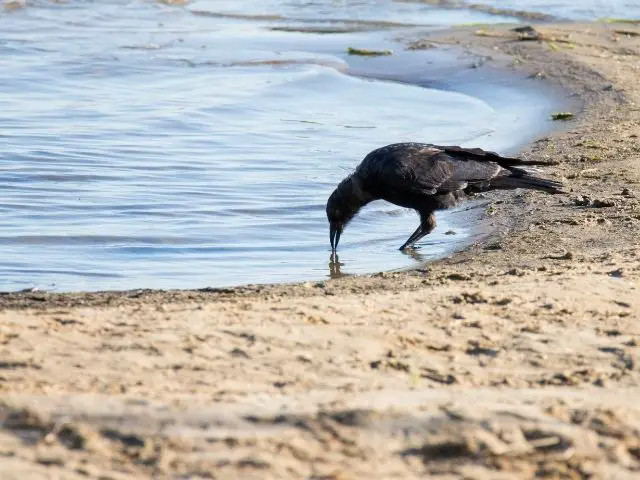
Crows are intelligent creatures, well-versed in taking advantage of a vast array of opportunities. The American crow is well-known for invading the nests of songbirds, stealing their eggs and their young, or robbing food or trinkets from humans.
This crow's loud and conspicuous voice is something you will most likely hear in agricultural areas and urban woodlands. There has been a significant population increase for this species around the San Francisco Bay Area in 2019.
Sadly, crows and ravens are unwelcome guests for their undesirable reputation of devastating crops and preying on smaller birds. Some would even go as far as attempting to eliminate them.
However, those who are not so fond of crows can wait for the crow hunting season in California. It's best to check out existing hunting regulations in the state before you even think about putting a crow down.
7. American Robin 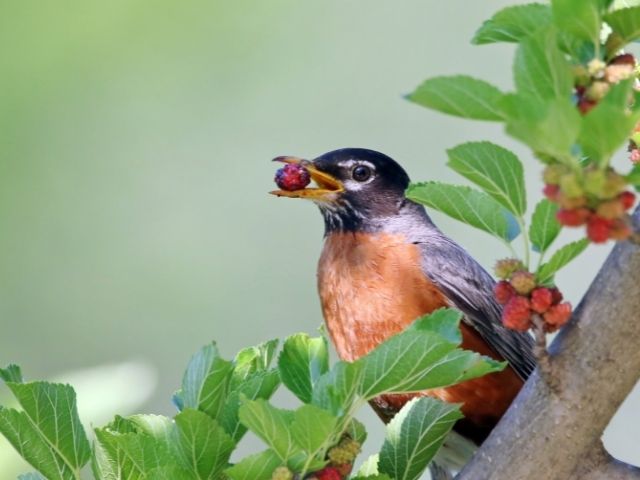
While you may see their kind foraging in orchards and vineyards, these creatures are particularly abundant in chaparral habitats. The presence of bountiful native shrubberies, such as fruit-bearing poison oak and toyon, lures American robins to such an environment.
The increase in the human population eventually leads to having more bird feeders. That, and some nest box programs in place across the Sierra Nevada, contribute to these robin's winter population increase in that area.
You can recognize this large-sized thrush with the males' rust-red breasts, nearly black head and tail, dark-streaked white throat, and white eye-rings. On the other hand, females almost share the same looks, except for their fainter rust-red breasts and grayish-brown heads.
It is partially migrant; its kind from Canada flies south, while its population in the United States is a resident across the continent. A few of these birds not belonging to either population fly southwest in winter.
Its feeding style is quite similar to a plover, walking, stopping, and picking as it feeds. It is not unusual to witness American robins roosting in tidal marshes. Robins sometimes dwell in shady woods where they mostly do ground-foraging for insects, earthworms, and berries.
8. House Sparrow 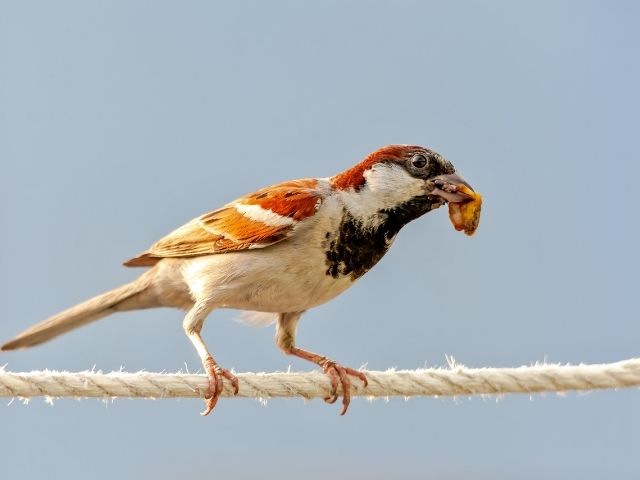
Among the Northern American sparrows, the house sparrow is undoubtedly the most common bird of its kind. Despite the white-crowned sparrow being a similarly widespread species, it is not as prevalent as house sparrows.
It's a stocky bird with a large-sized head and a finch-like bill; its bold streaks in black, brown, and gray might make this bird look handsome. Its looks could fool you, but despite how it feels comfortable to be around humans, many people find this bird disgusting.
Humans and native birds were disappointed when this sparrow first came north. House sparrows live in proximity to humans to utilize resources derived from human activity. Thus, seeing this sparrow taking crumbs from under your table is expected behavior.
Birders are rarely attracted to watching this bird, but it is far more interesting than any of us had been led to believe. Some people trying to avoid luring invasive species, such as this sparrow and the European starling, would stop supporting these birds' needs at backyard feeders.
Others would also find ways to exclude such birds from their nest boxes since they exploit native birds, taking over their nest cavities. Aside from the suburbia, you may also find these sparrows in grasslands, forests, or deserts.
Its spring and summer look is a pattern of gray and chestnut shade above and strikingly black from the throat to the breast. Relatively, these birds will have subtler looks in winter, with only minimal specks on their throats and breasts.
9. Red-Tailed Hawk 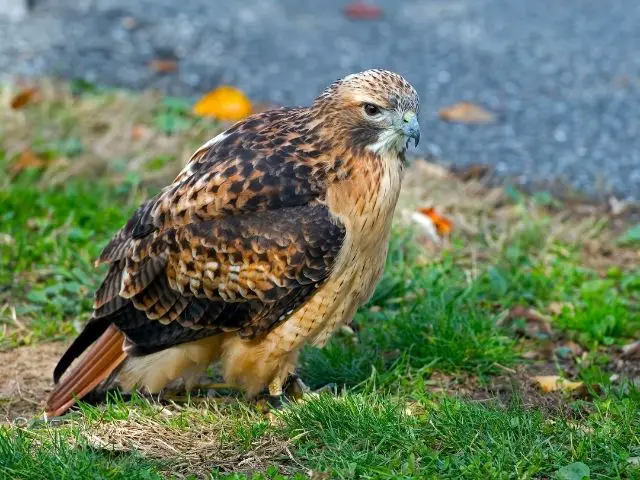
Red-tailed hawks are the most common buteo throughout the United States, and they have an extensive range. These predatory birds are also active residents of the Morro Bay Area during their nesting season.
Vital to the successful identification is knowing that this hawk has a variable plumage depending on its geographic range. It has fourteen subspecies; adults are famous for their rust-colored rounded tails, light underparts with a darker streak that forms a band across its belly.
The Harlan's Hawk subspecies from Alaska and Canada have gray-white tails, while the Krider's subspecies have theirs in a pink-washed hue. Red-tailed hawks forage the ground for potential prey, like rodents, rabbits, and squirrels.
It is well-known for its official call of the wild, commonly used as a sound effect in Hollywood movies. Its distinct cry sounds like a three-second shrill, a rasping scream that slurs downward.
A red-tailed hawk rarely forms flocks but often hunts in pairs, each hawk guarding the opposite sides of a tree when catching some squirrels. You will either see it soaring over cliffs or perching in scattered trees in a semi-open country.
10. Acorn Woodpecker 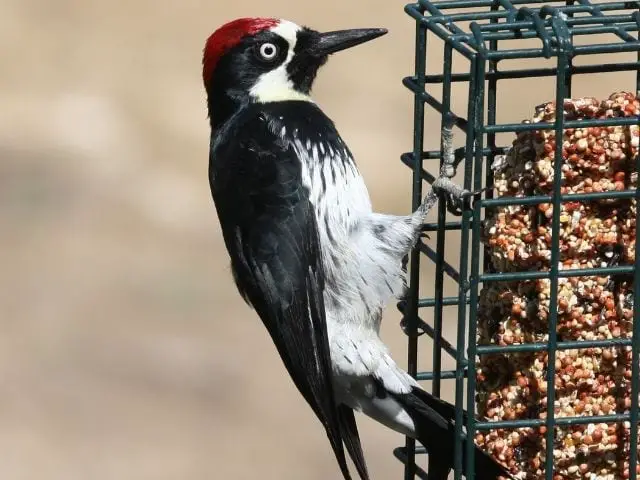
Acorns are gregarious birds with striking black and white plumage. Its back, tail, and wings are lustrous black, while its rump and underpart are white and have a distinctive red cap with a clown-like face.
Like Anna's hummingbird, this woodpecker is among the most wanted and the most viewed birds in southern California.
Contrary to the behavior of most North American woodpeckers, this creature hoards its food in tree holes. Each hole can accommodate an acorn, giving this bird the security of having a secured food supply in winter.
Also, acorn woodpeckers are not dependent on insects for their diet. These birds show a strong preference for dwelling in old forests. It is where they get acorns, their primary food, and likewise, aged trees have softer wood, allowing them to drill effortlessly.
Regardless of its primary habitat choice, you may also spot this woodpecker in wooded suburbs or dry oak and oak-pine woodlands.
11. Northern Mockingbird 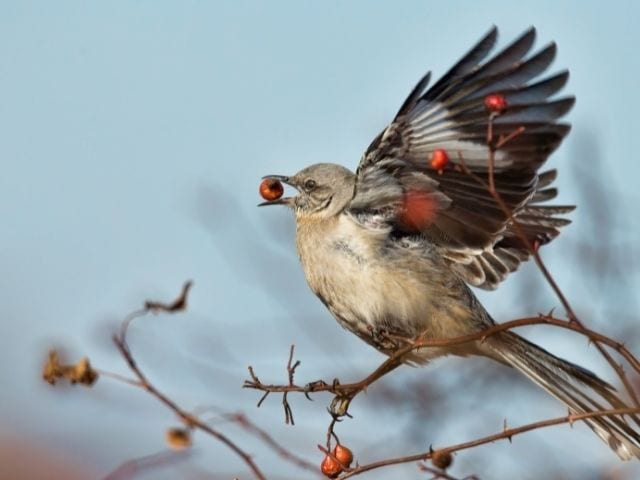
Northern mockingbirds are among the common backyard birds frequenting feeding stations in Santa Clara county. It is a familiar songbird that is well-known for its mimicry. This skillful creature can incorporate a hundred songs and calls from other birds into their vocal repertoire.
It formerly breeds in the south but is now expanding its range as far north as Canada, almost visible anywhere in the United States.
You can even find this songbird in elevated, dry regions in the state, a year-round resident in the western part's country gardens, farmlands, and suburbs. In winter, it's a casual visitor in the eastern region, except in the Owens Valley.
Northern mockingbirds are medium-sized birds with upper bodies in gray plumage, long tails and legs, and off-white to brownish-gray underneath. Insects and fruits are this bird's primary diet, which is why it safeguards fruit-bearing trees and shrubs from other birds.
Additionally, this mockingbird enjoys perching on lamp posts and wires while singing its beautiful song after dark in neighborhoods' artificial lighting.
12. Song Sparrow 
When it comes to geographical variation, song sparrows continue to reign in the north. This bird has varying plumage across its range, but both sexes look the same regardless of the location.
Song sparrows from the east have brown streaks on their backs, reddish-brown wings, a grayish-brown face, and streaked breasts and flanks. Contrastingly, song sparrows from California have grayish-brown upper bodies with contrasting dark marks.
This sparrow mainly forages the ground to feed insects and only consumes seeds when visiting backyard ground feeders. It's a regular visitor to suburban gardens, inhabiting roadsides, brushy marshes, thickets, and woodland edges near water.
People from the north could tell the arrival of springtime once they started hearing this bird's song. You can recognize its voice with its cheerful sound and varying pitch of chips and trills.
Frequently Asked Questions
What are the most common birds in Southern California?
There will never be a shortage of bird sightings for you to enjoy and learn from when you're in California's southern part. Located along the Pacific Flyway, this is the best place to watch migratory birds due to the region's diverse climate, landscape, and habitats.
It is hardly surprising that even birders from North America visit the spot to observe various bird species. The California thrasher and California towhee are some of the common birds in Southern California that you'll likely encounter along the north coast of Los Angeles.
In the brushy regions in the mountains of central San Diego County, you might chance upon the California quail and the greater roadrunner.
Even the El Dorado Nature Center is an excellent spot to witness the great blue heron perching in trees; the eared grebe also frequents Owens lake. Likewise, the mourning dove, black phoebe, and spotted towhee are common backyard birds of California in its southern part.
Here's a video of a Spotted Towhee in an estuary:
What is the most common of all backyard birds in California?
California is home to many house finches throughout the year; hence, it is the most common of all the birds you can find in the state. In truth, many birders consider this species to be the key to effective comparisons with unknown birds.
This undersized, rosy-cheeked bird is a regular visitor to most backyard bird feeders. Reported sightings of the house finch are at 44%, a significant number than the other California backyard birds, and most abundant during summer. Furthermore, this finch is visible in 61% of Los Angeles, 40% of San Francisco, and 55% of Sacramento.
What are the marine birds of California?
The California coastline is a significant habitat for many of the shorebirds in the state. Some of these birds use the coastal ecosystems for breeding, migrating, and winter territories. Marine birds rely on food sources available along the beaches.
You can spot the great blue heron year-round at Huntington Beach, while the eared grebe is only common in this area during fall and winter. However, the brown pelican remains the most abundant species on this beach while the waterfowl is also one of the common birds in Northern California that populate the San Francisco Bay area.
The nearshore waters are home to the common loon, while the California gull is visible all year on the sandy and rocky shores. You can enjoy sightings of the California scrub jay and California condor along the south coast of San Francisco and north of Los Angeles.
Final Thoughts
Birds have always been particularly fascinating to humans, admiring their plumages' beauty and marveling at the variety and exquisiteness of their songs. At least now we know better than merely settling for plumage-based field marks in identifying different species.
Once you understand that identifying specific birds is not the end-all and be-all in bird study, you will have a greater appreciation of avian life.
We'd like you to see this article as more than merely a comprehensive guide to California backyard birds. More than that, it is an introduction to increased awareness of each species diversity.

